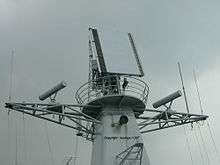Type 381 Radar
 | |
| Country of origin | People's Republic of China |
|---|---|
| Introduced | unknown |
| Number built | unknown |
| Type | 3D Air Search |
| Frequency | C band |
| Range | 100 kilometres (62 mi) |
| Altitude | 8000 m |
| Diameter | unknown |
| Azimuth | unknown |
| Elevation | unknown |
| Precision | unknown |
| Power | 150 kW |
| Other Names | Sea Eagle, RICE SHIELD, RICE SCREEN |
The Type 381 was one of the first Chinese naval 3D search radar employing FRESCAN (Frequency Scanning) technique developed by the Nanjing Marine Radar Research Institute / No. 724 Institute. Initial versions were deployed on Jiangdong class FFG and Luda command variant class to provide long range surface search.
Development
Decision was made to develop a naval 3-D radar designated as Type 381 in March, 1967, with 706th Institute to do initial research in the same year, which was subsequently transferred to 1014th Institute in the following year [1] In 1970, design task was once again transferred in August 1970, this time to 724th Institute. Shanghai Experimental Equipment Factory was originally assigned to build the prototype, with production begun in November 1970, and in 1974, the prototype was completed. Production subsequently transferred to Shanghai 4th Radio Factory in 1975. In 1977, the completed sample was installed on Frigate No. 531 for sea trials.[1]
While Type 381 was still under development in 1970, 724th Institute had already begun to plan a successor designated as Type 381A (Jia, 甲), which was formally approved in 1972.[1] The 772th Factory and other establishments were assigned to develop the traveling wave tube (TWT) needed and the 778th Factory was assigned to produce the TWT.[1] In April 1974, People's Liberation Army General Staff Department issued additional requirement to incorporate additional electronic countermeasure (ECM), and after seven year, the requirement was met by utilizing computers to control automatic frequency hopping technique as the main method of ECM.[1] By end of 1978, the first Type 381A was completed, with land-based trials conducted from end of 1979 to early 1980. In May 1983, Type 381A was installed on destroyer # 155, with sea trials conducted from December 1983 to January 1984, and accepted into service afterwards.[1] The 2nd Type 381A radar was completed on July 9, 1984, with land trials conducted between April and July 1985, and was authorized to proceed to sea trials in October of the same year. In October 1986, installation onboard Chinese destroyer No 110 was completed and sea trials were completed by the end of month. On December 12, 1987, state certification was received in Nanjing. Two more Type 381A radars were produced, installed on Chinese destroyer No. 165 and 166 respectively.[1] All earlier models in Type 381 series have been upgraded to Type 381B (Yi, 乙) before their final retirement from Chinese navy.
Design
Type 381 series naval radar is transistorized radar, and digitized integrated circuitry is also incorporated. The series is also computerized, with the incorporation of computers that can also provide target information to other weaponry systems onboard, and provide the best situation awareness and optimal attack plan to commanders.[1]
The original version Type 381 (also named as Sea Eagle C) won the 1987 First Prize of the National Science and Technology Progression, and it is judged by western intelligence as the Chinese equivalent of American AN/SPS-39. Type 381A radar is able to simultaneously detect 50 targets and tracking 10 of the 50. A follow-on of Type 381A is Type 381B (乙), which can simultaneously detect 80 targets and track 20 of the 80. Type 381 series has been superseded by Type 382. Initially, many have confused the "Sea Eagle S/C"(Type 382) installed on newer Chinese warships with the Russian 'Top Plate' (MR-710/760) or its copy, but with closer examination of the photos of both radar showed detailed differences, which link it to the "Type 381 radar" rather than the 'Top Plate' (MR-710/760).
Specifications
- Beam: 2.7° × 1.4°
- Peak power: 150 kW
- Pulse width: (original, 40), (Type A, 20), compressed to 1 microsecond
- PRF: (original, 370), (Type A, 730) average power of 2.2 kW
- Scan rate: 5 rpm
- Other features:
- Claimed able to track 10 targets simultaneously.
- Uses TWT+CFA coherent chain transmitter
- Reception is coherent with MTI improvement factor of 30 dBm
- Uses serpentine/waveguide